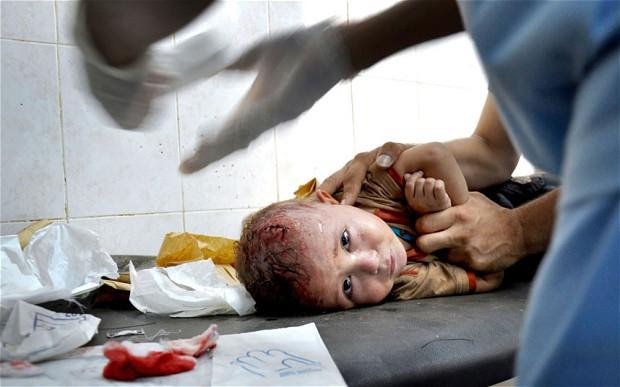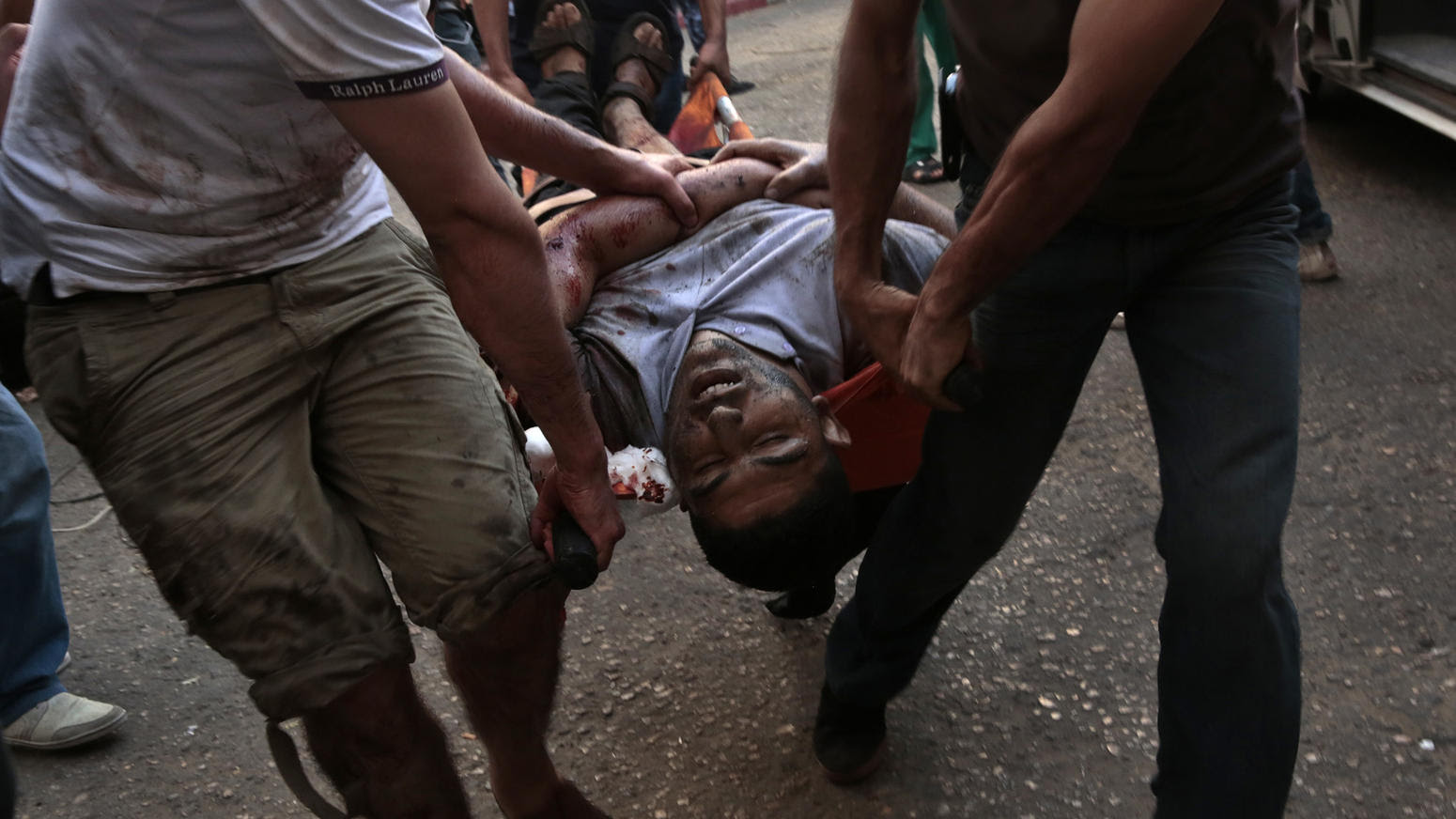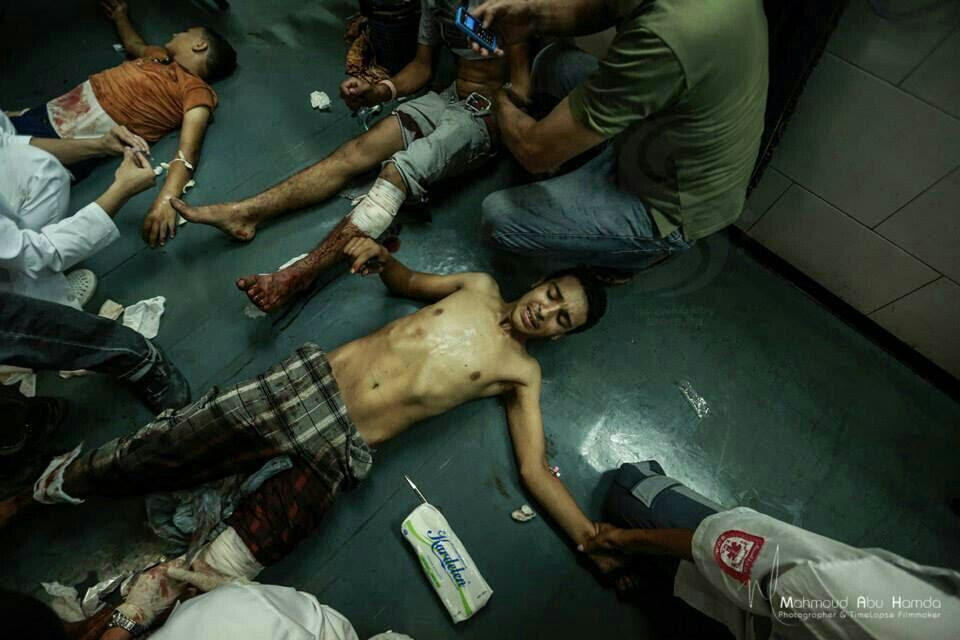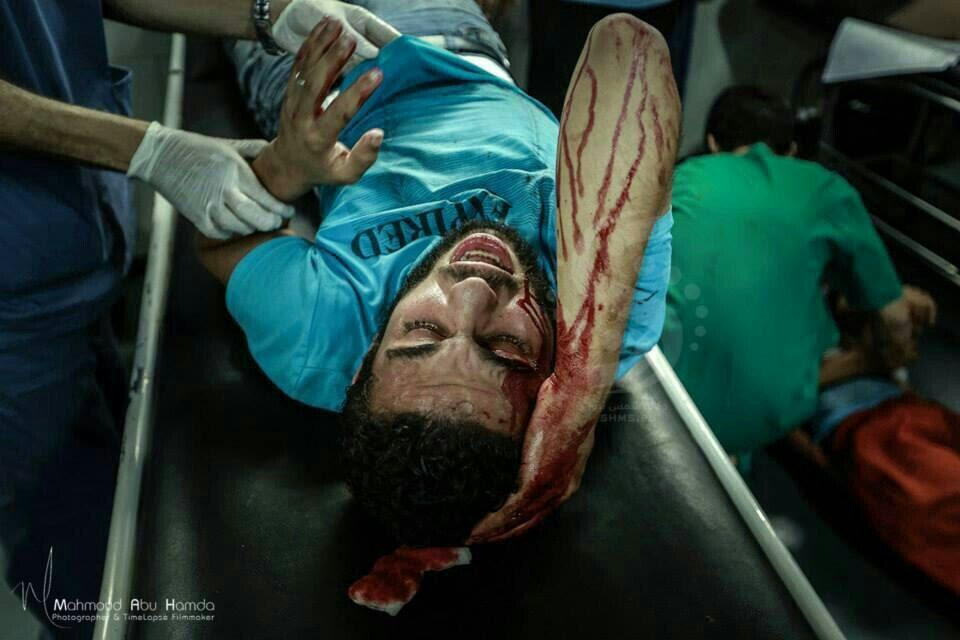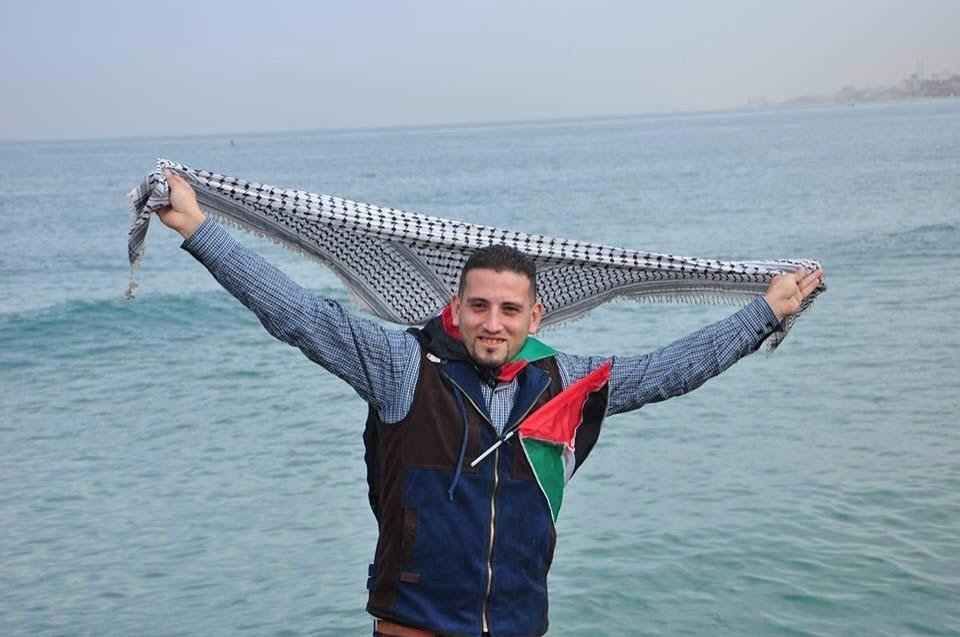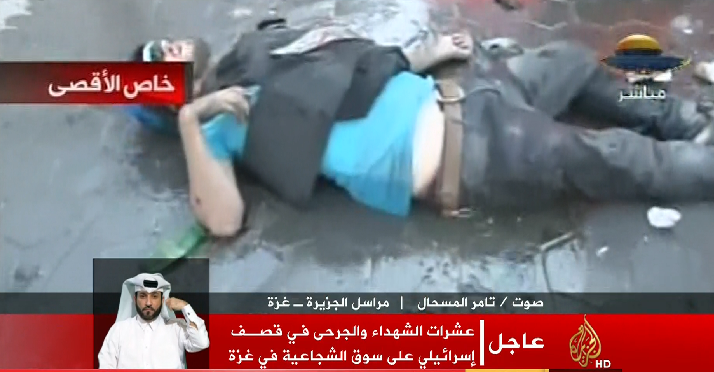.
 People flee bombing in the town of Nuseirat in the Gaza Strip on July 29: photo by Carolyn Cole / Los Angeles Times, 29 July 2014
People flee bombing in the town of Nuseirat in the Gaza Strip on July 29: photo by Carolyn Cole / Los Angeles Times, 29 July 2014
Three thousand people hiding for their lives from the mechano death thug army in a U.N. school in the northern Gaza Strip woke up to metal and fire before dawn this morning... no one knows...
This is Gaza right now. Wallahi, if this does not break your heart... then you are not a human: photo by EPA via Zaid Ali on twitter, 29 July 2014
Asmaa al-Ghoul: In Gaza, no one knows who will survive, Al-Monitor, 29 July 2014 (English translation by Reni Geha)
Gaza City, Gaza Strip -- No one feels the
suffering of Gaza’s people except the actual victims. It seems that only
the person who has been injured feels injury. Only the dead suffer in
death. Only those who lose their homes experience the loss.
Relatives
of a Palestinian man, who medics said was killed in an Israeli air
strike, mourn during his funeral in Khan Yunis in the southern Gaza
Strip: photo by Ibraheem Abu Mustafa / Reuters, 28 July 2014
The images of children being killed by tons of iron and
gunpowder have become a political goal. No matter the size of our grief,
it remains small compared to that of the actual victims who have been
injured, have lost loved ones or no longer have a home.
A Palestinian woman cries as she holds her son at a United
Nations-run school in
Jebalya refugee camp in the northern Gaza Strip. Witnesses said the school, which was sheltering Palestinians displaced by an Israeli
ground offensive, was hit by Israeli shelling on Tuesday: photo by Mohammed Salem / Reuters, 30 July 2014
What Israel is doing to the civilians of Gaza is shocking --
indiscriminate shelling and killing, destruction of entire residential
buildings with occupants inside. They say that death by bombing is
painless, but no one knows from where death will come. There is no safe place
for you or your family. You wonder why planes and shells are trying to
kill you as you sit with your family. Why are they killing your children
in front of you? Killing you in front of them? Killing all of
you, leaving no witness to your final moments?

Smoke rises from the Gaza power plant after it was hit by Israeli
strikes, in the Nusseirat Refugee Camp, central Gaza Strip on Tuesday. Israel escalated its military campaign against Hamas on
Tuesday, striking symbols of the group's control in Gaza and firing tank
shells that shut down the strip's only power plant in the heaviest
bombardment in the fighting so far. The plant’s shutdown was bound to
lead to further serious disruptions of the flow of electricity and water
to Gaza’s 1.8 million people: photo by Adel Hana / AP, 29 July 2014
Israel's intent to destroy the Dawud building, which is next to my
family's house and has been bombed several times, was conveyed in a
phone call to a building resident. Then the Israelis fired a warning
rocket on the afternoon of July 21. Everyone in the neighborhood began
screaming — nearby residents, the people in our house (from which the
building can be seen), the owner of a nearby restaurant and shop.
We and the neighbors went outside and left the keys in the doors. The
moment of horror is not when the missile pulverizes your body, but when
you realize that it is on the way, whether after receiving
notice or from the actual sound of the approaching shell.
Palestinians collect body parts in a classroom at the Abu Hussein U.N.
school in Jebaliya refugee camp, northern Gaza Strip, hit by an Israeli
strike earlier, on Wednesday, July 30, 2014. A Palestinian health
official says 15 people were killed after tank shells hit the U.N.
school in Gaza where hundreds of Palestinians had taken refuge from
Israeli attacks. Adnan Abu Hasna, a spokesman for a U.N. aid agency,
says tank shells hit the school around 4:30 a.m.: photo by Lefteris
Pitarakis / AP, 30 July 2014)
We reached a safe place. The initial shock dissipated, and our
thoughts turned to the pictures and memories we had left behind in the
house: babies' first steps, the drawing on the wall, my sister’s wedding
party in the living room.
Palestinian
relatives mourn for victims of a family near the rubble of their home
after it was destroyed by an Israeli airstrike in Rafah: photo by Said Khatib / AFP, 29 July 2014
You think that you are ready to start over as long as no one dies,
but the sadness in your heart makes you go on with your life even after
having lost your child or your mother to a shell that tore them to
pieces. The shell disfigures a body to the point that it becomes
unrecognizable. We try to console the orphans, but do we really know how
someone who lost his father or mother feels?

Palestinians
collect body parts in a classroom at Abu Hussein U.N. school in
Jebaliya refugee camp, northern Gaza Strip, hit by an Israeli strike on Wednesday, July 30: photo by Lefteris Pitarakis / AP, 30 July 2014
My family sought shelter in my cousins’ home. Earlier, at the
beginning of the war, my cousins had sought shelter in our home, but
suddenly their home became safer than ours. In this war, it is hard to
compare how safe different locations are. We ponder the mood of the
fighter pilots as to which family they will target that night. For
example, they warned the tower block next to us, but they bombed another
one without warning, killing the al-Kilani family. There is a complete
disregard for civilian life.
It is a war of religious ideologies. The bloodshed has come to be
seen as for the sake of God or heaven or the Promised Land. Feelings are
ignored as long as the political goal is being attained, and the
religious reward is on the way. When this happens, ideology
trumps humanity.
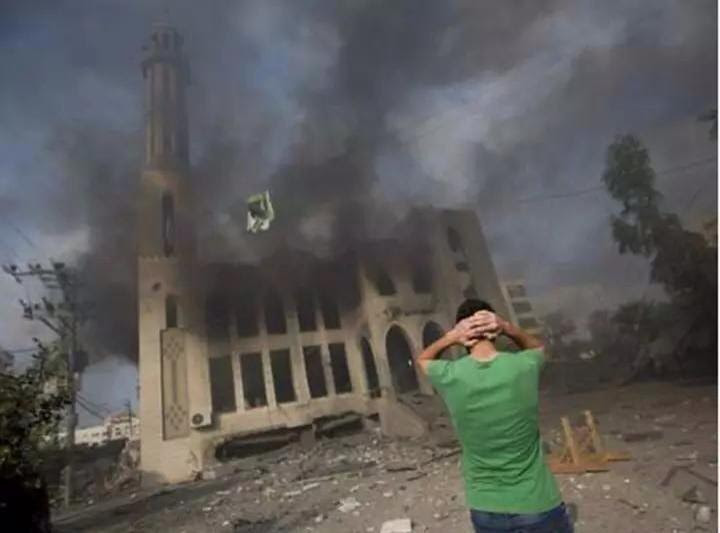 The mosque that I have always loved! Why!!: photo by Guess what via twitter, 30 July
2014
The mosque that I have always loved! Why!!: photo by Guess what via twitter, 30 July
2014
In the first week of the war, the media followed the story of Shaima
al-Masri, 4. The only family she has left is her father Ibrahim
al-Masri. Sitting next to his daughter, who lies in a bed in al-Shifa
Hospital, he said, “I thought that sending my wife to her
sister’s home will make her safe. But minutes later, I heard the
explosion. I ran down the street, then I received a phone call that my
son had been martyred. At the hospital entrance, I was told that my
wife was martyred. I found my eldest daughter, Asil, in critical
condition. She woke up for a few seconds and asked me where her mother
was, but then she died in the operating room … I later went to where
they got martyred and found that a plane had targeted them 10 meters
before they reached the house of my wife’s sister.” Shaima’s mother,
Sahar, her brother, Mohammed, 14, and her sister, Asil, 17, all died in
an Israeli air strike in the northern Gaza Strip on July 9.

Gaza's ONLY power station hit by the IDF, an
amazing act to add further misery to Gazans: photo via Dr Bassel Abuwarda on twitter, 29 July 2014
Where can children be safe? That was the question I kept asking
myself as I moved my children from house to house. I was separated from
my family for the first time when they decided to remain in my uncle’s
house. I preferred to take my son and daughter to another place until I
could find an apartment where we could again gather. I learned that some
people had left Gaza for Egypt. I don't think I can do the same. I
found one apartment, but its Palestinian owner doesn’t accept
Palestinians, only foreigners! Such is the racism and greed that the war
brings out in some people.
On the street in front of a hospital in Gaza, an injured man with his x-ray and a child wait to be treated: photo by Dr Bassel Abuwarda via twitter , 30 July 2014
If you listen to the partisan radio, you would think that our
strength is equal to Israel’s. It is a high moment and the point of no
return for the ideologues, whose stubbornness is equal to the blood
being shed. In their opinion, what I am saying is defeatist, but it is
simply natural fear for my family and sadness for the rest of the
children. Words of regret can no longer heal the pain.
I finally found an apartment next to the port. I want my family to
survive. I don’t know, no one knows, whether my family has survived or
if we have only temporarily escaped death.
I returned to al-Shifa, looking for the wounded from the al-Salam
residential building. I was informed, “There are no wounded. All of them
arrived dead.” Less than a day later came the Khuza’a disaster and the
indiscriminate shelling of Khan Yunis -- a new Shajaiya.
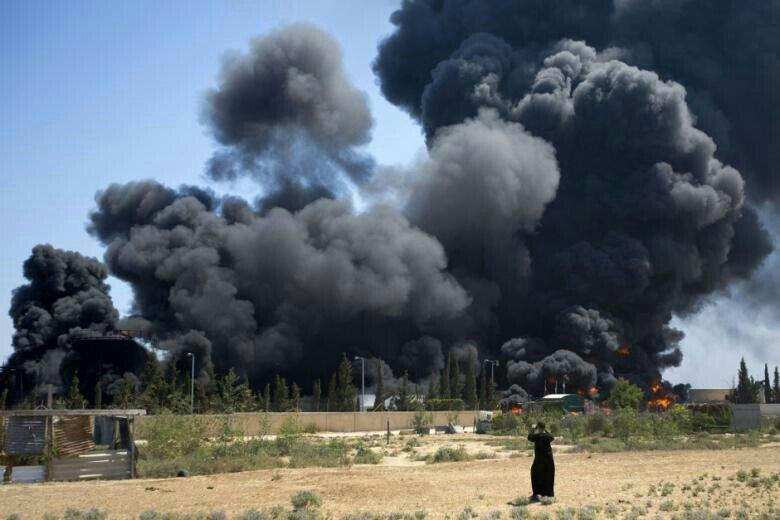
Gaza power plant is destroyed by an Israeli strike: photo via Dr Saeed Kanafany on twitter, 29 July 2014
I entered the pediatric surgery room, where I found a child named
Louay Siam, 9, entirely wrapped in bandages. His face and head were
burned, but you could still see his tears. His brother Uday Siam, 12,
lay in the next room with burns so severe his bones were exposed.
Their cousin Mohammed Siam said, “His mother, grandmother
and aunt were preparing pies on the roof of the house. The children were
playing in front of them when the Israeli jet bombed them. Nine of them
died.”
He is too beautiful and young to be dead.
258 children have been killed in Gaza: photo by Dr Bassel Abuwarda, 29 July 2014
Abu Zeid Abu Nasser, a neighbor of the Siams, said, “Uday and
Louay's father is a seller of fruits and vegetables that come from
Israel. He has nothing to do with any political party … I don’t know why
the plane bombed them … They've (the Israelis) gone crazy."
Abu Nasser pointed to the plastic tube in Louay’s nose that sucks the
ash from his lungs. He said, “[Louay’s] condition prevents him from
drinking water … He is crying because he’s thirsty.”
This is NOT the sun, it's an Israeli flare (bomb) thrown on Gaza: photo by Dr Bassel Abuwarda, 29 July 2014
In our new apartment, you can hear the sound of the sea mixed with
the sound of Israeli drones crossing the sky. Israel's warships fire
shells. It’s dark everywhere. The electricity has been out since
Israel hit the main station on July 23. On our battery-powered radio, we
heard Khaled Meshaal, head of Hamas's political bureau, saying, “We will not accept a truce without achieving
our conditions.” My heart sank, and I got ready for another day of
counting new casualties.
Asmaa al-Ghoul is a columnist for Al-Monitor's Palestine Pulse and a journalist from the Rafah refugee camp based in Gaza
 This is how Gaza looks at night without electricity and nonstop bombing: photo by Falasteen via twitter, 30 July 2014
This is how Gaza looks at night without electricity and nonstop bombing: photo by Falasteen via twitter, 30 July 2014
Doctors at Shifa Hospital try to keep a girl breathing after she was injured in an explosion in Gaza City: photo by Carolyn Cole / Los Angeles Times, 29 July 2014
An open letter for the people in Gaza: The Lancet, 23 July 2014
We
are doctors and scientists, who spend our lives developing means to
care and protect health and lives. We are also informed people; we teach
the ethics of our professions, together with the knowledge and practice
of it. We all have worked in and known the situation of Gaza for years.
On the basis of our ethics and practice, we are denouncing what we witness in the aggression of Gaza by Israel.
We
ask our colleagues, old and young professionals, to denounce this
Israeli aggression. We challenge the perversity of a propaganda that
justifies the creation of an emergency to masquerade a massacre, a
so-called “defensive aggression”. In reality it is a ruthless assault of
unlimited duration, extent, and intensity. We wish to report the facts
as we see them and their implications on the lives of the people.
We
are appalled by the military onslaught on civilians in Gaza under the
guise of punishing terrorists. This is the third large scale military
assault on Gaza since 2008. Each time the death toll is borne mainly by
innocent people in Gaza, especially women and children under the
unacceptable pretext of Israel eradicating political parties and
resistance to the occupation and siege they impose.
This
action also terrifies those who are not directly hit, and wounds the
soul, mind, and resilience of the young generation. Our condemnation and
disgust are further compounded by the denial and prohibition for Gaza
to receive external help and supplies to alleviate the dire
circumstances.
The blockade on Gaza has
tightened further since last year and this has worsened the toll on
Gaza's population. In Gaza, people suffer from hunger, thirst,
pollution, shortage of medicines, electricity, and a lack of any means to get an
income, not only by being bombed and shelled. Power crisis, gasoline
shortage, water and food scarcity, sewage outflow and ever decreasing
resources are disasters caused directly and indirectly by the siege.
People
in Gaza are resisting this aggression because they want a better and
normal life and, even while crying in sorrow, pain, and terror, they
reject a temporary truce that does not provide a real chance for a
better future. A voice under the attacks in Gaza is that of Um Al
Ramlawi who speaks for all in Gaza: “They are killing us all
anyway -- either a slow death by the siege, or a fast one by military
attacks. We have nothing left to lose -- we must fight for our rights, or
die trying.”
Gaza
has been blockaded by sea and land since 2006. Any individual of Gaza,
including fishermen venturing beyond three nautical miles of the coast
of
Gaza, faces being shot by the Israeli Navy. No one from Gaza can leave
by way of the only two checkpoints, Erez or Rafah, without special
permission
from the Israelis and the Egyptians, which is hard to come by for many,
if not impossible. People in Gaza are unable to go abroad to study,
work, visit families, or do business. Wounded and sick people cannot
leave easily to get specialised treatment outside Gaza. Entries of food
and medicines into Gaza have been restricted and many essential items
for survival are prohibited. Before the present assault, medical stock items in Gaza were already at an all time low because of the blockade.
They have run out now. Likewise, Gaza is unable to export its produce.
Agriculture has been severely impaired by the imposition of a buffer
zone, and agricultural products cannot be exported due to the blockade.
80% of Gaza's population is dependent on food rations from the UN.
Much
of Gaza's buildings and infrastructure had been destroyed during
Operation Cast Lead, 2008—09, and building materials have been blockaded
so that schools, homes, and institutions cannot be properly rebuilt.
Factories destroyed by bombardment have rarely been rebuilt adding
unemployment to destitution.
Despite the
difficult conditions, the people of Gaza and their political leaders
have recently moved to resolve their conflicts “without arms and harm”
through the process of reconciliation between factions, their leadership
renouncing titles and positions, so that a unity government can be
formed abolishing the divisive factional politics operating since 2007.
This reconciliation, although accepted by many in the international
community, was rejected by Israel. The present Israeli attacks stop this
chance of political unity between Gaza and the West Bank and single out
a part of the Palestinian society by destroying the lives of people of
Gaza. Under the pretext of eliminating terrorism, Israel is trying to
destroy the growing Palestinian unity. Among other lies, it is stated
that civilians in Gaza are hostages of Hamas whereas the truth is that
the Gaza Strip is sealed by the Israelis and Egyptians.
Gaza
has been bombed continuously for the past 14 days followed now by
invasion on land by tanks and thousands of Israeli troops. More than
60 000 civilians from Northern Gaza were ordered to leave their homes.
These internally displaced people have nowhere to go since Central and
Southern Gaza are also subjected to heavy artillery bombardment. The
whole of Gaza is under attack. The only shelters in Gaza are the schools
of the UN Relief and Works Agency for Palestine Refugees in the Near
East (UNRWA), uncertain shelters already targeted during Cast Lead,
killing many.
According to Gaza Ministry of Health and UN Office for the Coordination of Humanitarian Affairs (OCHA),
as of July 21, 149 of the 558 killed in Gaza and 1100 of the 3504
wounded are children. Those buried under the rubble are not counted yet.
As we write, the BBC reports of the bombing of another hospital,
hitting the intensive care unit and operating theatres, with deaths of
patients and staff. There are now fears for the main hospital Al Shifa.
Moreover, most people are psychologically traumatised in Gaza. Anyone
older than 6 years has already lived through their third military
assault by Israel.
 work on two wounded children at Shifa Hospital after an explosion in downtown Gaza City Monday, July 28, 2014: photo by Carolyn Cole / Los Angeles Times, 28 July 2014
work on two wounded children at Shifa Hospital after an explosion in downtown Gaza City Monday, July 28, 2014: photo by Carolyn Cole / Los Angeles Times, 28 July 2014
The massacre in Gaza
spares no one, and includes the disabled and sick in hospitals, children
playing on the beach or on the roof top, with a large majority of
non-combatants. Hospitals, clinics, ambulances, mosques, schools, and
press buildings have all been attacked, with thousands of private homes
bombed, clearly directing fire to target whole families killing them
within their homes, depriving families of their homes by chasing them
out a few minutes before destruction. An entire area was destroyed on
July 20, leaving thousands of displaced people homeless, beside wounding
hundreds and killing at least 70 --this is way beyond the purpose of
finding tunnels. None of these are military objectives. These attacks
aim to terrorise, wound the soul and the body of the people, and make
their life impossible in the future, as well as also demolishing their
homes and prohibiting the means to rebuild.
Weaponry
known to cause long-term damages on health of the whole population are
used; particularly non fragmentation weaponry and hard-head bombs.
We witnessed targeted weaponry used indiscriminately and on children
and we constantly see that so-called intelligent weapons fail to be
precise, unless they are deliberately used to destroy innocent lives.
We
denounce the myth propagated by Israel that the aggression is done
caring about saving civilian lives and children's wellbeing.
Israel's
behaviour has insulted our humanity, intelligence, and dignity as well
as our professional ethics and efforts. Even those of us who want to go
and help are unable to reach Gaza due to the blockade.
This “defensive aggression” of unlimited duration, extent, and intensity must be stopped.
Additionally,
should the use of gas be further confirmed, this is unequivocally a war
crime for which, before anything else, high sanctions will have to be
taken immediately on Israel with cessation of any trade and
collaborative agreements with Europe.
As
we write, other massacres and threats to the medical personnel in
emergency services and denial of entry for international humanitarian
convoys are reported.
We as scientists and doctors cannot keep silent while this crime
against humanity continues. We urge readers not to be silent too. Gaza
trapped under siege, is being killed by one of the world's largest and
most sophisticated modern military machines. The land is poisoned by
weapon debris, with consequences for future generations. If those of us
capable of speaking up fail to do so and take a stand against this war
crime, we are also complicit in the destruction of the lives and homes
of 1.8 million people in Gaza.
We
register with dismay that only 5% of our Israeli academic colleagues
signed an appeal to their government to stop the military operation
against Gaza. We are tempted to conclude that with the exception of this
5%, the rest of the Israeli academics are complicit in the massacre and
destruction of Gaza. We also see the complicity of our countries in
Europe and North America in this massacre and the impotence once again
of the international institutions and organisations to stop this
massacre.
Paola Manduca: New Weapons Research Group and University of Genoa, Genoa, Italy
Iain Chalmers: James Lind Library, Oxford, UK
Derek Summerfield: Institute of Psychiatry, King’s College, London, UK
Mads Gilbert: Clinic of Emergency Medicine, University Hospital of North Norway, Tromso, Norway
Swee Ang: Barts and the Royal London Hospital, London, UK
On behalf of 24 signatories.
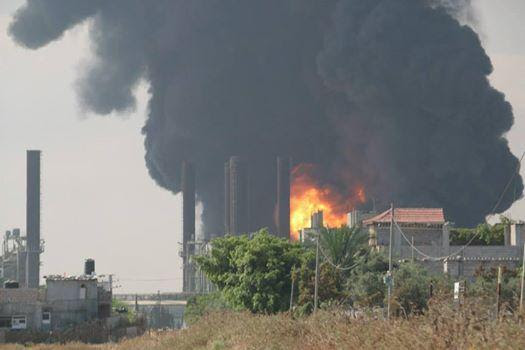 Fire at the Gaza power plant after Israeli strike. Officials say the
damage could take up to one year to repair -- supposing Israel grants
entry to engineers and spare parts: photo via Belal on twitter, 30 July 2014
Fire at the Gaza power plant after Israeli strike. Officials say the
damage could take up to one year to repair -- supposing Israel grants
entry to engineers and spare parts: photo via Belal on twitter, 30 July 2014

A Palestinian hugs his father who was wounded in an
Israeli strike on a compound housing a UN school in Jabaliya refugee
camp in the northern Gaza Strip, following their arrival at the Kamal
Edwan hospital in Beit Lahia: photo by Mohammed Abed / AFP, 30 July 2014
 Palestinians in Jebalya
refugee camp in the northern Gaza Strip collect the remains of bodies at a United
Nations-run school, which had been sheltering Palestinians displaced by the Israeli ground
offensive.Witnesses said the school was hit by Israeli shelling. Israeli tank
shells and air strikes on houses and the U.N. school in northern
Gaza killed at least 43 people and wounded many others, including 20 in the
school, health ministry spokesman Ashraf Al-Qidra said. Among the
dead were a medic and an infant. An Israeli army spokeswoman said she
was checking for details: photo by Mohammed Salem / Reuters, 30 July 2014
Palestinians in Jebalya
refugee camp in the northern Gaza Strip collect the remains of bodies at a United
Nations-run school, which had been sheltering Palestinians displaced by the Israeli ground
offensive.Witnesses said the school was hit by Israeli shelling. Israeli tank
shells and air strikes on houses and the U.N. school in northern
Gaza killed at least 43 people and wounded many others, including 20 in the
school, health ministry spokesman Ashraf Al-Qidra said. Among the
dead were a medic and an infant. An Israeli army spokeswoman said she
was checking for details: photo by Mohammed Salem / Reuters, 30 July 2014
 Smoke billows from the Gaza Strip: photo by Carolyn Cole / Los Angeles Times, 29 July 2014
Smoke billows from the Gaza Strip: photo by Carolyn Cole / Los Angeles Times, 29 July 2014

